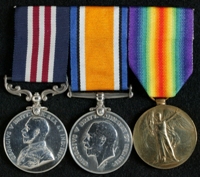

(L to R) Military Medal; British War Medal; Allied Victory Medal
Charles was born in October or early November 1895 in Shaw, near Oldham in Lancashire. He was baptised at Holy Trinity Church in the town on the 13th November. His father was called Brook and his mother was Elizabeth Ann. He had 2 older sisters called Ann and Alice.
When Charles was born his family lived on Manchester Road in Shaw, or Crompton as it was also known. In 1901 they lived at number 52, but we don't know if this was their address in 1895.
Brook died at the age of 38 between July and September 1899. In 1901 Elizabeth worked in one of Shaw's many cotton mills. Ann was 16 years older than Charles; she also worked in a mill.
In around 1905 Elizabeth remarried to Thomas Kenworthy. By 1911 they lived with Alice and Charles at 132 Rochdale Road in Shaw. Thomas was a machine minder, Alice was a card loom hand and Charles was a piecer. All 3 worked in a cotton mill. Elizabeth no longer had a job. We don't know which mill or mills any of them worked in.
The First World War broke out in August 1914 and Charles joined the Army on the 11th December 1915. Conscription would be introduced at the end of the year, but Charles enlisted under the Derby Scheme, where he volunteered and could choose the unit he joined, but was then assigned to the Army Reserve and returned home. He would then be called into service when he was needed. He chose the Manchester Regiment.
When he enlisted Charles was 5 feet 3 3/4 inches tall and weighed 109 pounds. He had 'normal' physical development and 'good' vision.
Charles was called up on the 21st January 1916 and assigned to the 27th Battalion of the Manchester Regiment. This was a training unit based at Southport, Lancashire until May 1916, when it moved to Altcar near Liverpool. He was given the service number 28400.
After finishing his training Charles was sent to Folkestone on the 24th June. He boarded a ship and crossed to Bolougne in France. He arrived at the 30th Infantry Base Depot in the large British camp at Etaples the next day.
When Charles arrived in France the 22nd Battalion was training to attack Mametz as part of the Somme Offensive. This began on the 1st July. We don't know whether Charles had joined the battalion in time to take part in this attack. Out of almost 800 men in the battalion, 472 were killed, wounded or went missing on the 1st July, so it is possible that Charles joined them later as a replacement for a casualty. When he did join them he became a member of D Company.
The battalion served around Mametz and Ginchy during July and August. On the 2nd September Charles was involved in digging new trenches and improving the ones that already existed. The battalion was doing this under German shellfire, and Charles was slightly wounded by some shrapnel. He was admitted to the XV Corps Main Dressing Station at Dernancourt the next day.
We don't know when Charles rejoined the 22nd Battalion. They moved north to the area around Ypres in Belgium during September, and stayed there until mid November, when they returned to the Somme area. The Somme Offensive ended in November, and the battalion spent the winter around Beaumont Hamel.
Charles was promoted to Unpaid Lance Corporal on the 26th January 1917. He began to be paid on the 2nd March. On the 23rd April he was promoted again, to Corporal. At this time the 22nd Battalion were in the rear area around Ablainzeville and Gomiecourt. The next day Charles became a Lance Sergeant. On the 27th July he was promoted to Sergeant. We don't know why Charles rose through the ranks so quickly. It could have been because casualties needed replacing.
In the autumn of 1917 the 22nd Battalion moved to Belgium and joined the Passchendaele Offensive that was fought around Ypres. They took part in 2 large attacks, from Polygon Wood towards Noordemdhoek on the 4th October and towards Gheluvelt on the 26th.
The Oldham Evening Chronicle newspaper printed an article on the 10th November reporting that Charles had 'written home saying he has been awarded the Military Medal for gallantry during an attack on October 4'. His award was published in the London Gazette on the 17th December. There was no citation with his award so we don't know exactly what he did or where he did it.
The 22nd Battalion served in their third country from November 1917 onwards, when they were sent to Italy. On the 24th October at Caporetto the Italians had suffered a serious defeat in their fight against Austria Hungary, so the British and French sent several units to help them. The 22nd Battalion stayed in Italy until the end of the war and played a major role in the final defeat of the Austrians.
Italy was a far quieter and safer theatre of war than France and Belgium. The 22nd Battalion was stationed around 4000 feet above sea level along the Piave River. They took part in the successful attack across this river in late October. The war in Italy ended on the 4th November.
The 22nd Battalion moved into Austria on occupation duty during February 1919. On the 16th March Charles left them there and returned to the UK for 14 days leave. Soon after he returned he was sent to Egypt. There had been disturbances by Egyptians who wanted independence from Britain and around 800 people had been killed. The worst was over by the time the 22nd Battalion arrived.
Charles served in Egypt for around 6 months. He was promoted to Acting Warrant Officer Class II on the 5th June and became a Company Sergeant Major. He returned to the UK in mid October and was demobilised from the Army on the 6th November.
Charles' life after this remains a mystery. His medals were donated to the Museum of the Manchester Regiment in February 1987.




